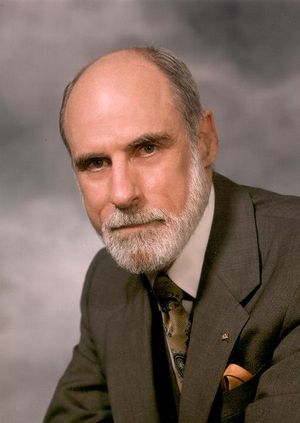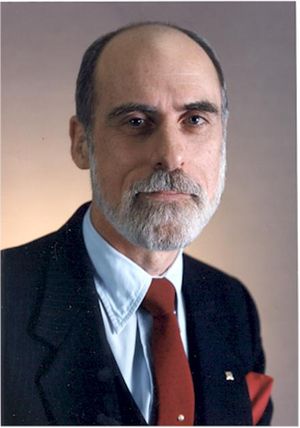Vinton Cerf: Difference between revisions
(New page: Image:Vinton G. Cerf 2387.jpg == Vinton Cerf == Vinton G. Cerf was born June 23, 1943 in New Haven, Connecticut. He received the B.S. degree in Mathematics/Computer Science from Stan...) |
No edit summary |
||
| (8 intermediate revisions by 3 users not shown) | |||
| Line 1: | Line 1: | ||
{{Biography | |||
|Image=Vinton G. Cerf 2387.jpg | |||
|Birthdate=1943/06/23 | |||
|Birthplace=New Haven, CT, USA | |||
|Associated organizations=Stanford University; MCI | |||
|Fields of study=Computing | |||
|Awards=[[IEEE Alexander Graham Bell Medal History|IEEE Alexander Graham Bell Medal]]; [[IEEE Medal of Honor]] | |||
}} | |||
[[Image:Vinton G. Cerf 2649.jpg|thumb|right]] | |||
Vinton G. Cerf was born June 23, 1943 in New Haven, Connecticut. He received the B.S. degree in Mathematics/Computer Science from Stanford University in 1965 and the M.A. and Ph.D. degrees in Computer Science from the University of California at Los Angeles in 1970 and 1972, respectively. | Vinton G. Cerf was born June 23, 1943 in New Haven, Connecticut. He received the B.S. degree in Mathematics/Computer Science from Stanford University in 1965 and the M.A. and Ph.D. degrees in Computer Science from the University of California at Los Angeles in 1970 and 1972, respectively. | ||
As early as 1969 Dr. Cerf and his colleague, [[Robert Kahn|Robert E. Kahn]], were already working on the U.S. Defense computer network, [[ARPANET]]. In 1972, Dr. Cerf joined the faculty of Stanford University. With Dr. Kahn, he conceived the transmission Control Protocol/Internet Protocol (TCP/IP) suite, the key technical innovation that permitted the transformation of the original ARPANET into today's Internet. In 1974, they outlined the design of the internetwork protocols in a paper entitled "A Protocol for Packet Network Intercommunications;' which was published in the IEEE Transactions on Communications. While the details of the protocols have changed to some extent, the essential concept was fully articulated in that first paper and remains viable today, over twenty years later. | As early as 1969 Dr. Cerf and his colleague, [[Robert Kahn|Robert E. Kahn]], were already working on the U.S. Defense computer network, [[ARPANET|ARPANET]]. In 1972, Dr. Cerf joined the faculty of Stanford University. With Dr. Kahn, he conceived the transmission Control Protocol/Internet Protocol (TCP/IP) suite, the key technical innovation that permitted the transformation of the original ARPANET into today's Internet. In 1974, they outlined the design of the internetwork protocols in a paper entitled "A Protocol for Packet Network Intercommunications;' which was published in the IEEE Transactions on Communications. While the details of the protocols have changed to some extent, the essential concept was fully articulated in that first paper and remains viable today, over twenty years later. | ||
Dr. Cerf played a major role in managing the development of Internet-related data packet technologies and network security programs while with the U.S. Department of Defense's Advanced Research Projects Agency from 1976 to 1982. It was during this time that he formed the Internet Configuration Control Board (ICCB), which evolved into the Internet Architecture Board (lAB), the body responsible today for technical oversight of the Internet architecture and standards process. | Dr. Cerf played a major role in managing the development of Internet-related data packet technologies and network security programs while with the U.S. Department of Defense's Advanced Research Projects Agency from 1976 to 1982. It was during this time that he formed the Internet Configuration Control Board (ICCB), which evolved into the Internet Architecture Board (lAB), the body responsible today for technical oversight of the Internet architecture and standards process. | ||
| Line 13: | Line 19: | ||
As Corporate Vice President of the Corporation for National Research Initiatives, he was responsible for managing the National Digital Library and packet network research projects. He conducted national research efforts on information infrastructure technologism, co-inventing knowledge robots (mobile software agents used in computer networks) with Dr. Kahn. | As Corporate Vice President of the Corporation for National Research Initiatives, he was responsible for managing the National Digital Library and packet network research projects. He conducted national research efforts on information infrastructure technologism, co-inventing knowledge robots (mobile software agents used in computer networks) with Dr. Kahn. | ||
Dr. Cerf returned to MCI Corporation as Senior Vice President of Internet Architecture and Engineering in 1992. He is responsible for the development of MCI's Internet network. Vinton Cerf is a [[IEEE Fellow Grade History|Fellow of the IEEE]], the Association for Computing Machinery, the American Association for the Advancement of Science, and the American Academy of Arts and Sciences. He has received numerous awards and commendations in connection with his work on the Internet. They include: the C&C Prize from the Foundation for Computer and Communication Promotion, the Industry Legend Award from the Computer and Communications Industries Association, the IEEE Koji Kobayashi Computer and Communications Award, the 1996 Computerworld/Smithsonian Leadership Award and the Silver Medal of the International Telecommunication Union. | Dr. Cerf returned to MCI Corporation as Senior Vice President of Internet Architecture and Engineering in 1992. He is responsible for the development of MCI's Internet network. Vinton Cerf is a [[IEEE Fellow Grade History|Fellow of the IEEE]], the Association for Computing Machinery, the American Association for the Advancement of Science, and the American Academy of Arts and Sciences. He has received numerous awards and commendations in connection with his work on the Internet. They include: the C&C Prize from the Foundation for Computer and Communication Promotion, the Industry Legend Award from the Computer and Communications Industries Association, the IEEE Koji Kobayashi Computer and Communications Award, the 1996 Computerworld/Smithsonian Leadership Award and the Silver Medal of the International Telecommunication Union. | ||
One of the founders of the Internet Society, Dr. Cerf speaks to groups around the world about the Internet. | One of the founders of the Internet Society, Dr. Cerf speaks to groups around the world about the Internet. | ||
Dr. Cerf was co-recipient, along with Dr. Robert Kahn of the 1997 IEEE Alexander Graham Bell Medal 'For conceiving the Internet architecture and protocols, and for the vision and sustained leadership that led to the current Internet.' | Dr. Cerf was co-recipient, along with Dr. Robert Kahn of the 1997 [[IEEE Alexander Graham Bell Medal History|IEEE Alexander Graham Bell Medal]] 'For conceiving the Internet architecture and protocols, and for the vision and sustained leadership that led to the current Internet.' | ||
== Further Reading == | |||
[[Oral-History:Vinton Cerf|Vinton Cerf Oral History]] | |||
[[Category: | [[Category:Computing and electronics]] | ||
[[Category: | [[Category:Distributed computing]] | ||
[[Category:Internet]] | [[Category:Internet]] | ||
{{DEFAULTSORT:Cerf}} | |||
Latest revision as of 18:59, 16 January 2024
- Birthdate
- 1943/06/23
- Birthplace
- New Haven, CT, USA
- Associated organizations
- Stanford University, MCI
- Fields of study
- Computing
- Awards
- IEEE Alexander Graham Bell Medal, IEEE Medal of Honor
Biography
Vinton G. Cerf was born June 23, 1943 in New Haven, Connecticut. He received the B.S. degree in Mathematics/Computer Science from Stanford University in 1965 and the M.A. and Ph.D. degrees in Computer Science from the University of California at Los Angeles in 1970 and 1972, respectively.
As early as 1969 Dr. Cerf and his colleague, Robert E. Kahn, were already working on the U.S. Defense computer network, ARPANET. In 1972, Dr. Cerf joined the faculty of Stanford University. With Dr. Kahn, he conceived the transmission Control Protocol/Internet Protocol (TCP/IP) suite, the key technical innovation that permitted the transformation of the original ARPANET into today's Internet. In 1974, they outlined the design of the internetwork protocols in a paper entitled "A Protocol for Packet Network Intercommunications;' which was published in the IEEE Transactions on Communications. While the details of the protocols have changed to some extent, the essential concept was fully articulated in that first paper and remains viable today, over twenty years later.
Dr. Cerf played a major role in managing the development of Internet-related data packet technologies and network security programs while with the U.S. Department of Defense's Advanced Research Projects Agency from 1976 to 1982. It was during this time that he formed the Internet Configuration Control Board (ICCB), which evolved into the Internet Architecture Board (lAB), the body responsible today for technical oversight of the Internet architecture and standards process.
Between 1982 and 1986, he was Vice President of Engineering for MCI Digital Information Services Company. In this capacity he was responsible for the design and implementation of MCI Mail, one of the first commercial electronic mail services.
As Corporate Vice President of the Corporation for National Research Initiatives, he was responsible for managing the National Digital Library and packet network research projects. He conducted national research efforts on information infrastructure technologism, co-inventing knowledge robots (mobile software agents used in computer networks) with Dr. Kahn.
Dr. Cerf returned to MCI Corporation as Senior Vice President of Internet Architecture and Engineering in 1992. He is responsible for the development of MCI's Internet network. Vinton Cerf is a Fellow of the IEEE, the Association for Computing Machinery, the American Association for the Advancement of Science, and the American Academy of Arts and Sciences. He has received numerous awards and commendations in connection with his work on the Internet. They include: the C&C Prize from the Foundation for Computer and Communication Promotion, the Industry Legend Award from the Computer and Communications Industries Association, the IEEE Koji Kobayashi Computer and Communications Award, the 1996 Computerworld/Smithsonian Leadership Award and the Silver Medal of the International Telecommunication Union.
One of the founders of the Internet Society, Dr. Cerf speaks to groups around the world about the Internet.
Dr. Cerf was co-recipient, along with Dr. Robert Kahn of the 1997 IEEE Alexander Graham Bell Medal 'For conceiving the Internet architecture and protocols, and for the vision and sustained leadership that led to the current Internet.'
Further Reading

